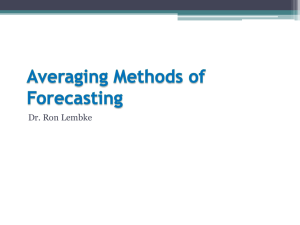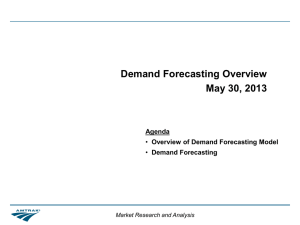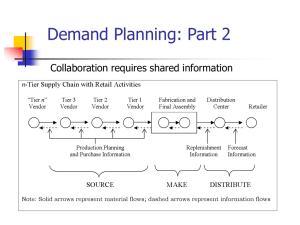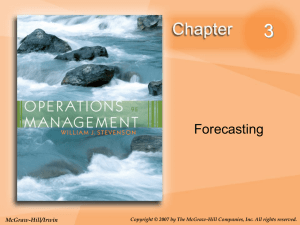Decomposition of Times Series Data with
advertisement
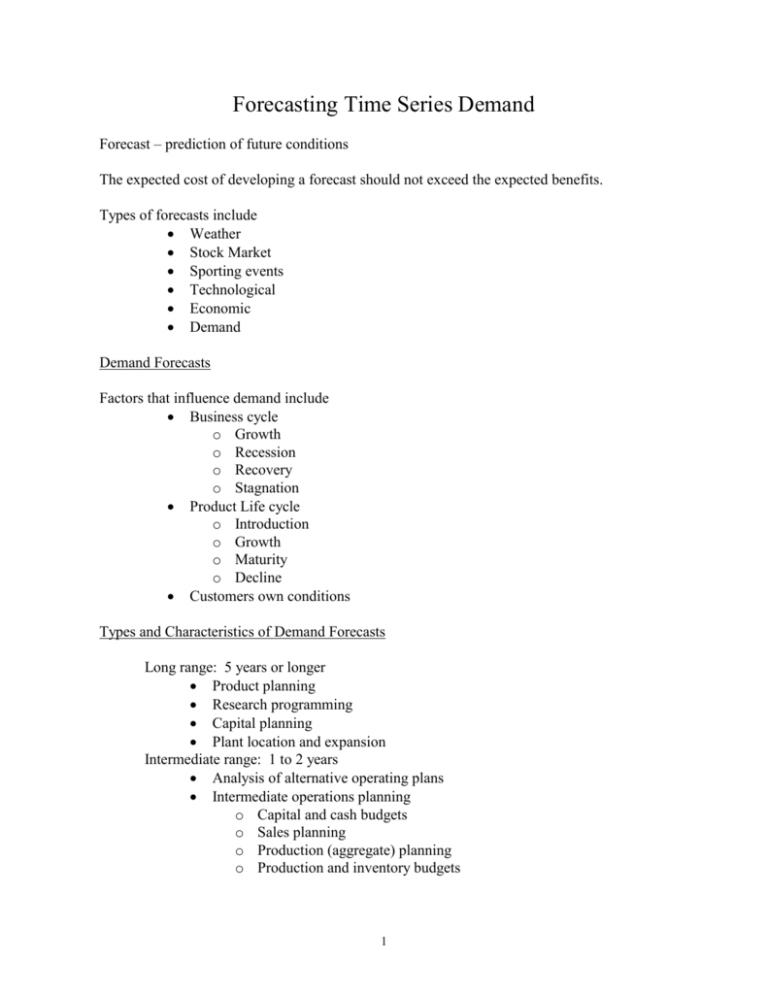
Forecasting Time Series Demand Forecast – prediction of future conditions The expected cost of developing a forecast should not exceed the expected benefits. Types of forecasts include Weather Stock Market Sporting events Technological Economic Demand Demand Forecasts Factors that influence demand include Business cycle o Growth o Recession o Recovery o Stagnation Product Life cycle o Introduction o Growth o Maturity o Decline Customers own conditions Types and Characteristics of Demand Forecasts Long range: 5 years or longer Product planning Research programming Capital planning Plant location and expansion Intermediate range: 1 to 2 years Analysis of alternative operating plans Intermediate operations planning o Capital and cash budgets o Sales planning o Production (aggregate) planning o Production and inventory budgets 1 Short range: 1 day to 1 year Adjustment of production and employment Job scheduling Project assignment Overtime decisions Forecasting of demand for goods or services can be done in many different ways. Figure 1 illustrates how the various techniques can be classified. FORECASTING QUANTITATIVE TECHNIQUES CAUSAL MODELS QUALITATIVE TECHNIQUES TIME SERIES MODELS EXPERT OPINIONS GROUP PROCESSES Figure 1. Classification of forecasting techniques. Qualitative techniques rely on experience that has not been captured in the form of hard data. Quantitative techniques rely on historical data. Causal models are based on finding a cause and effect relationship. For example, housing permits have a cause relation to demand for building materials and appliances and the level of disposable income has a cause relationship to purchases of luxury items. It is important that the cause variable is a leading indicator, i.e., it can be measured in advance of the demand it is assumed to cause. Causal models are usually developed using a linear regression approach based on the method of least squares. Our focus here is on time series models. Time series demand is viewed as a sequence of observed values, which we will denote by A1 , A2 , · · · ,An These models attempt to identify patterns that have been present in the past and assume they will continue in the future. These models are often termed extrapolation models. We typically search for four major components in past demand: 1. 2. 3. 4. Average or base Trend Seasonal Cyclical 2 The average or base component is the average level of demand, which may or may not change over time. The trend component is the overall upward or downward drift in demand that occurs over time. A time series that has no trend is called stationary; if trend is present the time series is nonstationary. The seasonal component is a pattern that repeats over time in one-year cycles. For example, demand might be relatively high in spring and fall and relatively low in summer and winter. The cyclical component refers to patterns that persist over cycles many years in length. Our discussion will not deal with cyclical components. The Forecasting Process All forecasting methods proceed in three separate steps as follows: 1. Use past data to estimate the parameters of the model. 2. Use estimated parameters to determine how well the time series model would have done in predicting past demand. 3. Use estimated parameters to forecast demand for the future. Stability Versus Responsiveness In forecasting, the stability of a model is its ability to not be overly influenced by an observation that appears to be a chance occurrence that does not fit with the rest of the time series. The responsiveness of a model is its ability to quickly react to changes in the pattern of the time series. Stability and responsiveness are controlled by the settings of various parameters in the model and a setting that improves one will have an adverse influence on the other. Stability vs Responsiveness 200 190 180 170 160 Actual Forecast 150 140 130 120 110 100 1 2 3 4 5 6 7 Period Figure 2. Stability versus responsiveness. 3 8 9 Figure 2 above illustrates the issue. For the first 8 periods, the forecasts have done a very good job of predicting actual demand. However, in period 9, the demand took a significant upward jump far in excess of the forecast. That would likely lead to problems in operations in period 9, but now the question is should the forecast for period 10 be responsive and move to levels near the period 9 actual demand or be stable and continue with a value near to the forecasts of recent periods. However, unless we know that the period 9 demand spike was temporary as shown in Figure 3 or permanent as shown in Figure 4, the choice between stability and responsiveness will be based on intuition. Stability vs Responsiveness 200 190 180 170 160 Actual Forecast 150 140 130 120 110 100 1 2 3 4 5 6 7 8 9 10 11 12 13 Period Figure 3. Temporary demand spike. Stability vs Responsiveness 200 190 180 170 160 Actual Forecast 150 140 130 120 110 100 1 2 3 4 5 6 7 8 9 10 Period Figure 4. Permanent demand shift. 4 11 12 13 Measuring Accuracy of Forecasting Methods There are many ways in which the accuracy of a forecasting method is evaluated. They all involve looking at past data and comparing the value that would have been forecasted using the model and the estimated parameters, Ft , with the actual observation, At. The first two measures we will discuss, mean absolute deviation (MAD) and mean square error (MSE) evaluate the error without regard to the error being high or low. They are calculated by 1 n 1 n MAD At Ft MSE ( At Ft ) 2 n t 1 n t 1 The next measure discussed here is sum of forecast errors (SFE), which unlike MAD and MAD, provides an indication of bias (overestimation or underestimation) in the method. SFE is calculated by n SFE ( At Ft ) t 1 Finally, we describe the tracking signal (TS) which is calculated as TS = SFE/MAD A tracking signal outside the range (-3.0,+3.0) indicates significant bias issues that should be investigated including the use of the wrong type of model. Table 1. Forecast Examples Period 1 2 3 4 5 6 Actual Demand 112 115 118 116 120 125 Forecast A 110 113 116 114 118 123 Forecast B 110 117 116 118 118 127 In Table 1, two different forecasts are presented along with actual demand for 6 periods. Close inspection reveals, the while both forecasts consistently missed the actual demand by two units, forecast A is always two units low while forecast B alternates between being high and low. 5 Table 2 SFE, MAD and MSE for Forecast Methods A and B METHOD A Period 1 2 3 4 5 6 Actual Demand 112 115 118 116 120 125 Forecast 110 113 116 114 118 123 Error 2 2 2 2 2 2 Absolute Error 2 2 2 2 2 2 Squared Error 4 4 4 4 4 4 SFE 12 MAD 2 MSE 4 TS = 6.0 METHOD B Forecast 110 117 116 118 118 127 Error 2 -2 2 -2 2 -2 Absolute Error 2 2 2 2 2 2 Squared Error 4 4 4 4 4 4 SFE 0 MAD 2 MSE 4 TS = 0.0 Table 2 shows the calculation of SFE, MAD and MSE for forecasting methods A and B. Note that MAD and MSE are the same for both methods. However, SFE is 12 and TS is 6.0 for method A and both are 0 for method B, which illustrates that SFE and TS are able to detect bias. STATIONARY MODELS The two models described here, moving averages and exponential smoothing, are appropriate when it is unlikely that there is trend present in the demand. Moving Average The moving average model has a single parameter, k, which is the number of periods used in the average. The forecast for a given period is then the average of the previous k periods. For example, for period t+1 Ft 1 At At 1 At k 1 k A higher value of k produces a more stable model while a smaller value of k produces a more responsive model. If forecasts are required for several periods in the future, the forecast for the first period is used for all subsequent periods. Weighted average models use weights for the periods involved in the calculation, usually assigning higher weights to later periods. 6 Exponential Smoothing Exponential smoothing models are calculated by Ft 1 Ft ( At Ft ) At (1 ) Ft The parameter, α, is called the smoothing constant and must be a value between 0 and 1 with higher values leading to greater responsiveness and lower values to greater stability. This can be observed by expanding the calculation above to the equivalent form Yˆt 1 At (1 ) At 1 (1 ) 2 At 2 (1 ) 3 At 3 This expression shows that higher weights are given to more recent demand observations. As was the case with moving average, if forecasts are required for several periods in the future, the forecast for the first period is used for all subsequent periods. Example The following table shows actual demand data for the final 9 months of 2007 along with forecasts that were made by simple moving average (SMA) (six months) and exponential smoothing (ES) (α = 0.2). Month Actual SMA ES Apr-07 May-07 Jun-07 115 104.8 104.8 111 108.0 106.8 120 111.7 107.7 Jul-07 99 111.5 110.1 Aug-07 Sep-07 Oct-07 Nov-07 Dec-07 132 109.5 107.9 120 114.8 112.7 141 116.2 114.2 116 120.5 119.5 141 121.3 118.8 Calculate MAD, MSE, SFE and TS for both forecasts for the nine months displayed. Which performed better? Make forecasts for the first three months of 2008 by both methods. Solution The following table displays MAD, MSE and SFE Simple Moving Average Exponential Smoothing MAD 12.30 13.53 MSE 210.52 250.43 SFE 76.67 92.37 TS 6.23 6.83 In every error measure, simple moving average outperforms exponential smoothing. Since both these methods don’t address trend or seasonality, the forecasts for the first three months of 2008 will be the same for each month. The two forecasts are given by 7 Simple moving average Forecast = (99+132+120+141+116+141)/6 = 124.8 Exponential smoothing Forecast = 0.2(141) +(1.0 - 0.2)(118.8) = 123.3 NONSTATIONARY MODELS The next five models are appropriate for nonstationary time series, i.e., time series in which trend is present. The first of the five, double exponential smoothing, deals with base and trend alone, while the last four also deal with seasonality. Double Exponential Smoothing This method calculates an estimate of the base or expected level of demand in period t (denoted by Et) and an estimate of the trend, i.e., the increase or decrease per period (denoted by Tt). Using these values, the forecast for period t+n (n periods after the current period) is given by Ft n Et nTt The values of base and trend are updated by the following Et At (1 ) ( Et 1 Tt 1 ) Tt ( Et Et 1 ) (1 )Tt 1 The parameter α (0 < α < 1) is used to smooth the base and the parameter β (0 < β < 1) is used to smooth the trend. As in the exponential smoothing model, higher values of the smoothing parameters lead to more responsiveness while smaller values lead to more stability. Example The following table shows actual demand data (same as in earlier example) for the final 9 months of 2007 along with forecasts that were made by double exponential smoothing (α = 0.2 and β = 0.3). In addition to displaying the forecasts, the table also displays the base and trend estimates. 8 Apr-07 May-07 Jun-07 Jul-07 Aug-07 Sep-07 Oct-07 Nov-07 Dec-07 Month Actual 115 111 120 99 132 120 141 116 141 Forecast 119.74 121.86 122.11 123.98 119.78 123.75 124.30 129.95 128.63 Base 118.79 119.69 121.69 118.98 122.22 123.00 127.64 127.16 Trend 3.07 2.42 2.29 0.80 1.53 1.30 2.30 1.47 Calculate MAD, MSE , SFE and TS for both forecasts for the nine months displayed. Which performed better? Make forecasts for the first three months of 2008. Assuming the demand turns out to be 155 in January 2008, make new forecasts for February and March 2008. Solution The following table displays MAD, MSE and SFE MAD 11.30 Double Exponential Smoothing MSE 173.18 SFE -19.10 TS -1.69 Note double exponential smoothing performs better than simple moving average and exponential smoothing, particularly for SFE and TS. This is strong evidence that there is trend present in actual demand data. We begin by updating the base estimate by E = (0.2)(141) + (1.0 – 0.2) (127.16 + 1.47) = 131.10, and then updating the trend estimate by T = (0.3) (131.10 – 127.16) + (1.0 – 0.3) (1.47) = 2.21. The forecasts for January, February and March are Jan: 131.10 +(1) (2.21) = 133.31 Feb: 131.10 +(2) (2.21) = 135.52 Mar: 131.10 +(3) (2.21) = 137.73 With the new data point of January 2008 demand we update base as E = (0.2)(155) + (1.0 – 0.2) (131.10 + 2.21) = 137.65 , And the trend as = (0.3) (137.65 – 131.10) + (1.0 – 0.3) (2.21) = 3.51 9 The new forecasts for February and March 2008 are Feb: 137.65 +(1) (3.51) = 141.16 Mar: 137.65 +(2) (3.51) = 144.67 Holt-Winters Additive Method In addition to the base and trend estimates of double exponential smoothing (E and T), the Holt-Winters methods include estimates of the seasonal factors for periods (denoted by S). The parameters p, states the number of seasonal periods in a year. For example, p = 12 would correspond to monthly seasonal adjustments and p = 4 would correspond to quarterly seasonal adjustments. In the additive version, the forecast for period t+n (n periods after the current period) is given by Ft n Et nTt S t n p The values of base and trend and the seasonal factors are updated by the following Et ( At S t p ) (1 ) ( Et 1 Tt 1 ) Tt ( Et Et 1 ) (1 )Tt 1 S t ( At Et ) (1 ) S t p As before, α and β smooth base and trend while the parameter γ (0 < γ < 1)is used to smooth trend. The forecasting formula Ft n Et nTt S t n p can be used for any number of future periods as long as one interprets the final term to be the most recent estimate of seasonality for the period being forecasted. Holt-Winters Multiplicative Method The multiplicative version of the Holt-Winters method uses seasonal factors as multipliers rather than additive constants. The forecast for period t+n is given by Ft n ( Et nTt ) S t n p 10 The values of base and trend and the seasonal factors are updated by the following Et At (1 ) ( Et 1 Tt 1 ) St p Tt ( Et Et 1 ) (1 )Tt 1 St At (1 ) S t p Et Regression Based Decomposition Additive Method The two regression based decomposition models begin with a simple linear regression model using the period numbers (1, 2, · · · , n) as the independent variable and the demand observations (A1 , A2 , · · · ,An) as the dependent variable. The resulting slope (denoted by a) and intercept (denoted by b) are then used to calculate trend estimates given by Tt a t b Then in the additive model, we calculate differences by Dt At Tt Seasonal indices (denoted by St) are then calculated by averaging all values of Dt that correspond to a particular seasonal period. For example, in a times series consisting of 51 months beginning in January 2000 and ending in March 2004, the seasonal index for January would be calculated by averaging the five differences D1, D13, D25, D37 and D49. Indices for February and March would also average 5 differences. However, for the remaining nine monthly indices, the averages would be based on only 4 values. Once the monthly indices are calculated the forecasting formula Ft (a t b) St where St is interpreted as the appropriate seasonal index for period t. This formula would be used both for past periods in determining MAD, MSE and SFE and for estimating demand in future periods. Regression Based Decomposition Multiplicative Method This model begins like the additive model with the regression and calculation of trend estimates (these values are the same for both models). However, in the multiplicative model, we calculate ratios by 11 Rt At Tt Seasonal indices (denoted by St) are then calculated by averaging all values of Rt that correspond to a particular seasonal period. Once the monthly indices are calculated the forecasting formula Ft (a t b) St where St is interpreted as the appropriate seasonal index for period t. As in the additive model, this formula would be used both for past periods in determining MAD, MSE and SFE and for estimating demand in future periods. HOMEWORK The table on the following page presents data regarding actual demand and forecasts for two products, A and B, in the six months from October 2007 to March 2008. Three forecasting methods were used as follows: 1. Simple moving average using six periods 2. Exponential smoothing with α = 0.25 3. Double exponential smoothing with α = 0.20 and β = 0.30 For each product and each of the three forecasting method, calculate MAD, MSE, SFE and TS. Using simple moving average and exponential smoothing, make demand estimates for products A and B for the months April 2008, May 2008 and June 2008. For the double exponential smoothing model and for both products A and B. use the March 2008 demand to revise the base and trend estimates (not shown in the table). Use the updated values to make estimates for both products A and B for the months April 2008, May 2008 and June 2008. Summarize your results in the three tables below the problem data table. 12 PROBLEM DATA Month Actual Demand Product A Demand Product B Demand Simple Moving Average Product A Forecasts Product B Forecasts Exponential Smoothing Product A Forecasts Product B Forecasts Double Exponential Smoothing Product A Base Trend Forecast Product B Base Trend Forecast Oct-07 Nov-07 Dec-07 Jan-08 Feb-08 Mar-08 2680 1260 2600 1220 2350 1200 2630 1290 2400 1220 2620 1280 2563.3 1176.7 2571.7 1198.3 2573.3 1206.7 2526.7 1218.3 2520.0 1235.0 2496.7 1236.7 2509.4 1185.7 2552.1 1204.2 2564.1 1208.2 2510.5 1206.1 2540.4 1227.1 2505.3 1225.3 2540.68 2551.31 -1.55 2.10 2505.86 2539.14 2512.73 -10.10 2553.41 2528.10 2500.51 -2.46 -10.00 2502.63 2525.64 2490.52 1226.46 1238.51 16.67 15.28 1218.08 1243.13 1243.03 12.06 1253.79 1262.07 1264.98 14.15 10.78 1255.09 1276.22 1275.75 Simple Moving Average MAD Error Measures MSE SFE TS Apr-08 Forecasts May-08 Jun-08 Error Measures MSE SFE TS Apr-08 Forecasts May-08 Jun-08 Product A Product B Exponential Smoothing MAD Product A Product B 13 Double Exponential Smoothing Error Measures MAD MSE SFE Product A Product B TS 14 Apr-08 Forecasts May-08 Jun-08




